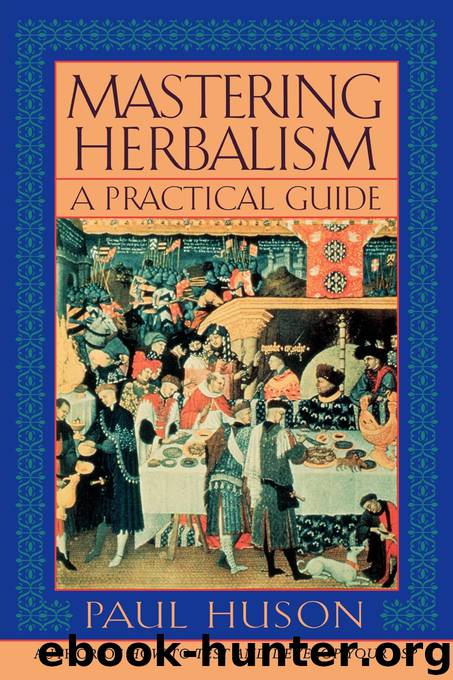Mastering Herbalism by Huson Paul

Author:Huson, Paul.
Language: eng
Format: epub
Publisher: Madison Books
Published: 2001-02-27T16:00:00+00:00
Sachets and Potpourris
The easiest way to employ herbal fragrance is in a sachet or potpourri. Sachets are little bags of highly scented aromatic herbs and spices. Once people carried them about on their persons, although today cologne has replaced them in this area. They are, however, still used to perfume linen closets and keep the moths out, and they make delightful gifts at Yule. A jar of fragrant herbs and spices kept about the house for its perfume’s sake alone is known as a potpourri. Sachets and potpourris in fact are practically interchangeable terms.
Today most commercially available sachets and potpourris are heavily perfumed with artificial floral essences. Any homemade sachet of your own will usually be far superior in quality. For one thing, you can choose your own ingredients, and, for another, you can make quite sure allergenic chemicals are not incorporated. Needless to say, you also get the chance to be truly creative rather than to buy your pleasure ready-made. A sachet or potpourri can be anything from a simple collection of dried fragrant leaves and petals from your garden to an involved mixture of herbs, spices, and oils, carefully balanced and blended according to your own or a traditional formula over a long period of time. You may find that when you start formulating sachet mixes of your own you will have an overwhelming desire to innovate and explore new combinations. Go right ahead. The secret of perfume-making—and this applies to sachets too—is to find fragrances that “click” together, that is, “interlock” to form a third, totally new scent. If they do not click, you will still have two separate and quite distinguishable perfumes. “That smells like peppermint and roses,” will be an outsider’s comment here rather than, “That’s fantastic! How did you make it?”
A sachet or a potpourri contains three basic types of ingredients:
1. An agent, or primary scent, often in liquid form;
2. A base, or secondary scent, sometimes called a blender, usually an herb;
3. A fixative, generally a resin, wood, or root.
The agent and the base are the two scents mentioned earlier which have to click together. The fixative, often a comparatively neutralsmelling resin, is added to cement the union. Floral essential oils are often used as agents and, though powerful, they are volatile and evaporate quickly, leaving you with your secondary ingredient. However, if a harmonious fixative is added, it will absorb the agent and incorporate its perfume in its own, thus extending its short life considerably. A well-made sachet or potpourri can in fact retain its potency for up to thirty or forty years.
There are literally innumerable sachet and potpourri recipes in existence. Every handwritten “still-room book,” descendant of the old herbal, halfway between a family cookbook and a home doctor, usually contains dozens of personal favorites of the master or lady of the household. Many of them require ingredients now difficult or impossible to obtain, like real musk and ambergris, or else in such vast quantities as could be expected only from the owners of palatial country estates.
Download
This site does not store any files on its server. We only index and link to content provided by other sites. Please contact the content providers to delete copyright contents if any and email us, we'll remove relevant links or contents immediately.
Turbulence by E. J. Noyes(7936)
The Thirst by Nesbo Jo(6828)
Gerald's Game by Stephen King(4583)
Be in a Treehouse by Pete Nelson(3950)
Marijuana Grower's Handbook by Ed Rosenthal(3623)
The Sprouting Book by Ann Wigmore(3543)
The Red Files by Lee Winter(3368)
The Remains of the Day by Kazuo Ishiguro(3294)
Sharp Objects: A Novel by Gillian Flynn(2958)
Christian (The Protectors Book 1) by L. Ann Marie(2654)
Organic Mushroom Farming and Mycoremediation by Tradd Cotter(2628)
The Culinary Herbal by Susan Belsinger(2431)
Stone Building by Kevin Gardner(2353)
The Starter Garden Handbook by Alice Mary Alvrez(2283)
Lilac Girls by Martha Hall Kelly(2258)
The Unlikely Pilgrimage of Harold Fry by Rachel Joyce(2220)
The Lean Farm Guide to Growing Vegetables: More In-Depth Lean Techniques for Efficient Organic Production by Ben Hartman(2096)
Urban Farming by Thomas Fox(2061)
Backyard Woodland by Josh VanBrakle(1895)
